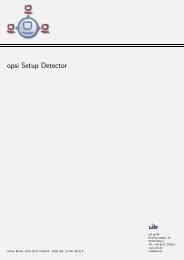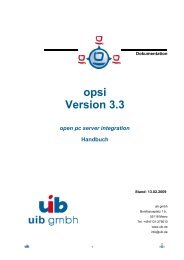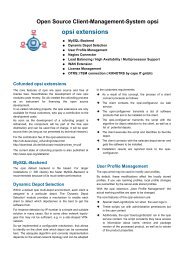opsi Version 3.3.1 - opsi Download - uib
opsi Version 3.3.1 - opsi Download - uib
opsi Version 3.3.1 - opsi Download - uib
You also want an ePaper? Increase the reach of your titles
YUMPU automatically turns print PDFs into web optimized ePapers that Google loves.
5. Netboot products: Automated OS installation and more<br />
At first the PC only knows its hardware ethernet address (MAC), consisting of six two-<br />
digit HEX characters.<br />
The firmware initiates a DHCPDISCOVER broadcast: “I need an IP address, who is my<br />
DHCP-Server?“<br />
The DHCP-Server offers an address (DHCPOFFER).<br />
DHCPREQUEST is the response of the client to the server if the IP address is<br />
accepted. (This is not an obsolete step as there could be more than one server in the<br />
network.)<br />
The server sends a DHCPACK to acknowledge the request. The information is sent to<br />
the client again.<br />
You can watch this process on the display, for the PXE-BOOTPROM displays some<br />
firmware information and its 'CLIENT MAC ADDR'. The rotating pipe-symbol is<br />
displayed during the request. When an offer was made it is replaced by an '\' and you<br />
get the transmitted information (CLIENT IP, MASK, DHCP IP, GATEWAY IP).<br />
A short while later you should get a response like this: 'My IP ADDRESS SEEMS TO<br />
BE ......'.<br />
This process makes the PC a regular, fully configured member of the network.<br />
The next step is to load the boot file (boot image) given in the configuration information.<br />
5.1.3.1. Loading pxelinux<br />
The boot image is loaded via trivial file transfer protocol (tftp). The displayed message is<br />
„LOADING“. tftp is a rather old and simple protocol to transfer files without<br />
authentication. In fact, all data available via tftp is available to everyone in the network.<br />
Therefore the tftp access is limited to one directory, which is usually '/tftpboot'. This<br />
directory is specified in inetd (internet daemon, /etc/inetd.conf), which will start the tftp<br />
daemon 'tftpd' if requested. The start command as noted in inetd.conf is something like<br />
tftpd -p -u tftp -s /tftpboot.<br />
The PXE boot-process is multi-stage:<br />
77








